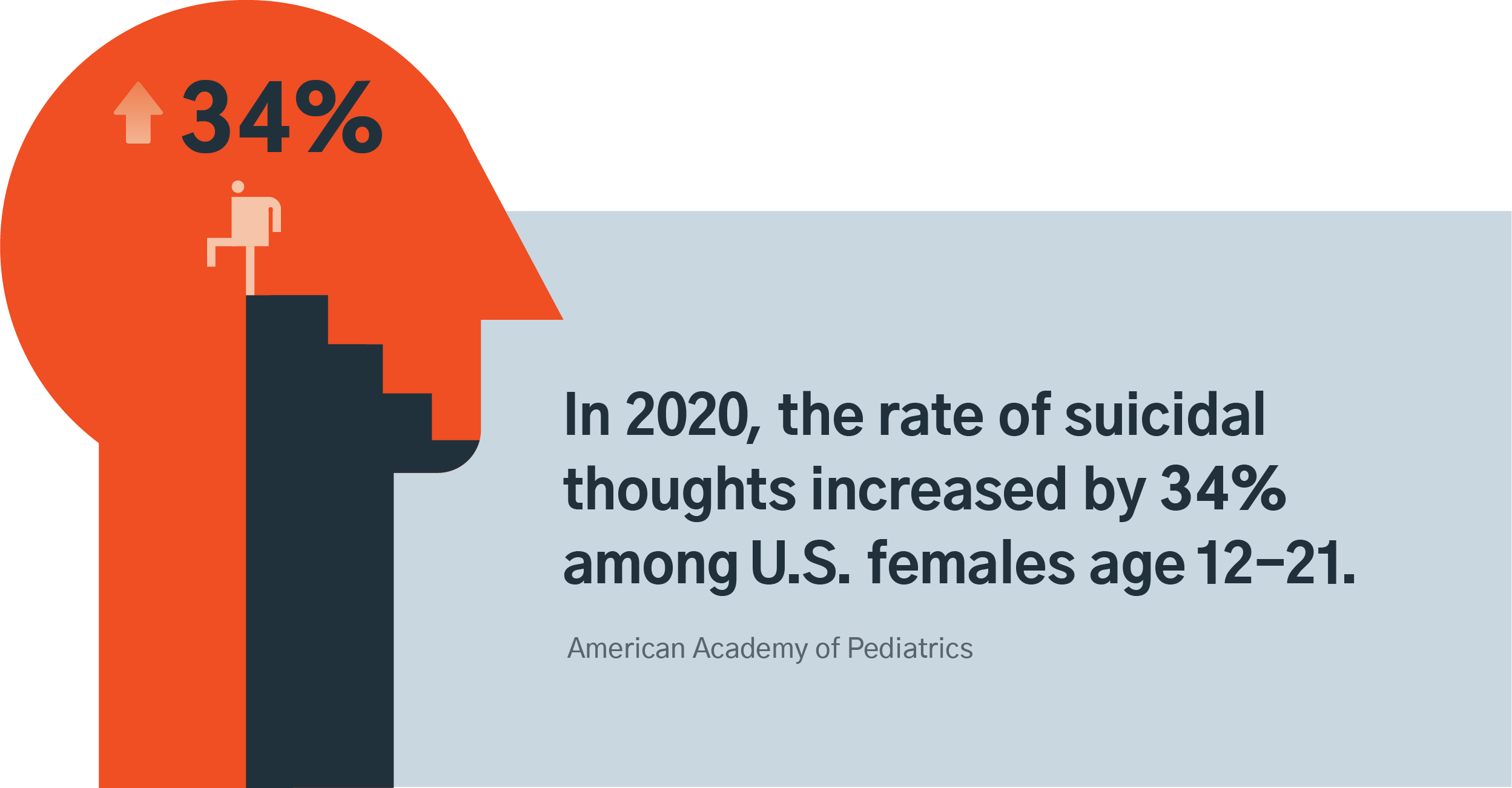
Suicide cuts short too many young people’s lives. The need for accessible and effective mental health resources for this age group has never been more urgent. Almost 20% of high school students seriously consider suicide and nearly 9% attempt it [7].
Early recognition, assessment and intervention is key. But effective interventions that aren’t appealing to teens aren’t the solution, and accessible solutions that aren’t effective aren’t either—we need more digital solutions that are developed for teens, with input from teens, and with scientific evidence to back them up.
| If you or someone you know is struggling, there are resources to help. The National Suicide Prevention Lifeline is available 24 hours a day in English and Spanish at 1-800-273-8255 or you can text the Crisis Text Line by texting HELLO to 741741 |
Rising Concerns with Adolescent Mental Health
Suicidal thoughts and behaviors, which are the strongest predictors of future suicide attempts or completions [2], often emerge during adolescence. The onset of many mental health disorders also occurs during this period [3].
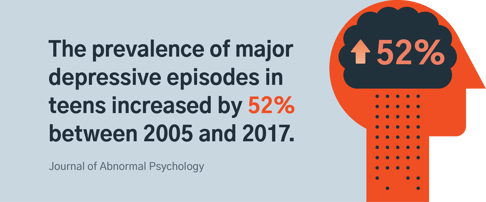
Worldwide, approximately 10-20% of teens struggle with mental health problems [4], and in the U.S., about 16.5%, or 7.7 million, of teens have at least one mental health disorder [5]. And these numbers are increasing at an alarming rate, more so than among adults [6] - the prevalence of major depressive episodes in teens increased by 52% between 2005 and 2017, and serious psychological distress increased by 71% between 2008 and 2017 [7].
Unfortunately, we’ve seen a corresponding increase in suicidal thinking, attempts, and deaths by suicide too. Between 2007 and 2017, deaths by suicide among American teens aged 15 to 19 increased. Specifically, deaths by suicide increased by 2.6% per year between 2007 and 2014 and then by 14.2% per year between 2014 and 2017 [8]. In 2017, the rate of deaths by suicide among 15 to 19-year-olds was 17.9 per 100,000 among males and 5.4 per 100,000 among females [8]. In 2019, suicide was the second leading cause of death among 13 to 19-year-olds, surpassed only by unintentional injury [9].
Data from the CDC’s Youth Risk Survey suggests suicidal ideation and attempts are even more common. In 2019, 18.8% of high school students reported seriously considering suicide, and 8.9% reported attempting suicide [10]. Female students and students from marginalized backgrounds, including students of color and those who identify as LGBTQ, are particularly at risk for suicidal ideation and attempts [10], though generally males are more likely to die by suicide [11].
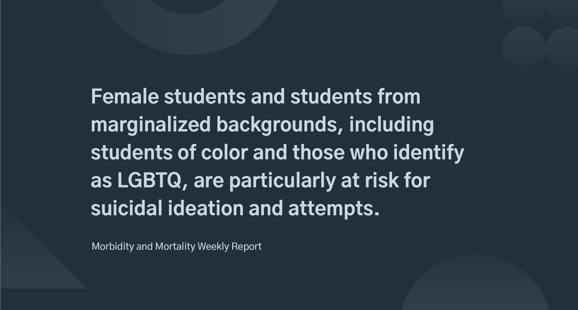
Adolescents During the COVID-19 Pandemic
Although the pandemic has been hard on everyone, data from the American Psychological Association’s annual Stress in America survey suggest it’s been particularly hard on Gen-Z, including teens. Half of the teens aged 13 to 17 in their survey reported that the pandemic “severely disrupted their plans for the future” and felt planning for their future was impossible. Forty-three percent reported that their stress levels increased over the previous year [12].
So it should come as no surprise that the pandemic has taken a toll on their mental health as well. In Spain, statistics show that suicide attempts increased by 25% among adolescents, and particularly among adolescent girls, whereas the suicide attempts among adults actually dropped by 16.5% [13]. Similarly, in the U.S., rates of depression and suicide risk have increased. Among U.S. females between 12 and 21, the rate of recent suicidal thoughts increased by 34% [14]. CDC data further shows that the rate of emergency department visits for suspected suicide attempts among teens aged 12 to 17 increased by 51% for females and 4% for males between February and March of 2021 compared to two years earlier [15].
A Focus on Prevention
National trends suggest use of outpatient mental health services, including psychotherapy and psychotropic medications, among teens have increased over time [16]. 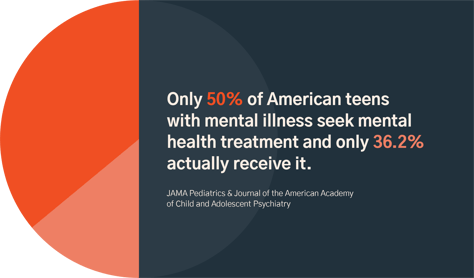 But this increase appears to be driven mostly by teens with less severe or no mental health impairment [16]. Given the shortage of mental health service providers for youth, particularly in rural and low income areas [17], this means that the teens with a greater need for mental health services may not be receiving care. Indeed, only 50% of American adolescents with mental illness seek mental health treatment [18] and only 36.2% actually receive treatment [19].
But this increase appears to be driven mostly by teens with less severe or no mental health impairment [16]. Given the shortage of mental health service providers for youth, particularly in rural and low income areas [17], this means that the teens with a greater need for mental health services may not be receiving care. Indeed, only 50% of American adolescents with mental illness seek mental health treatment [18] and only 36.2% actually receive treatment [19].
More broadly, 52% between 10 and 17 years of age with high psychological distress report no current clinical contact [20]. By comparison, it is estimated that 44.8% of U.S. adults with any mental illness and 65.5% of those with serious mental illness receive mental health treatment [21], suggesting the unmet need for mental health care may be greater for adolescents than for adults.
This unmet need for mental health services among youth, which has only increased during the COVID-19 pandemic [22], highlights the importance of expanding services for youth. Importantly, given that much of the strain on mental health services for youth is from those with less severe, or no, impairment, interventions focused more on preventing future dysfunction and impairment are important [23]. For instance, programs that help build resilience, a factor that mitigates suicide risk, may help mental health and suicidal behavior among teens, whether they are presently low- or higher-risk [24].
Going Digital: How We Reach Today’s Youth
Given the lack of specialists and long wait times for youth mental health services [25], attempts to address growing mental health concerns among teens requires scalable and accessible solutions. School-based intervention programs have been proposed as one way to address mental health and suicide risk among teens [26]. However, interventions can be difficult to implement in schools due to lack of time, lack of resources, and financial constraints [27]. Consequently, students from socially and economically disadvantaged schools may be less likely to have access to these kinds of interventions [28].
These school-based intervention programs are further limited under circumstances where students are not attending schools in person, as many students experienced around the globe during the COVID-19 pandemic, despite the fact that these are circumstances where students may need these interventions most.
Online interventions may help solve this dilemma. 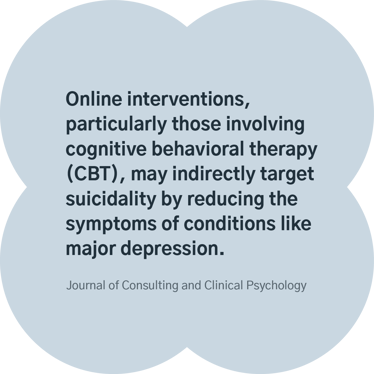 Given that 92% of teens report going online daily, and 25% report that they are ‘almost constantly’ connected [29], a digital intervention could offer a more effective and less costly approach to reaching more people. Indeed, scholars have called for the importance of evidence-based digital interventions to support people struggling with suicidal thoughts, particularly during the pandemic, when access to support is more difficult [30]. Digital solutions may be particularly appealing to teens.
Given that 92% of teens report going online daily, and 25% report that they are ‘almost constantly’ connected [29], a digital intervention could offer a more effective and less costly approach to reaching more people. Indeed, scholars have called for the importance of evidence-based digital interventions to support people struggling with suicidal thoughts, particularly during the pandemic, when access to support is more difficult [30]. Digital solutions may be particularly appealing to teens.
Research also shows that young people find online and mobile interventions acceptable and enjoyable to use [31], and they seem to be particularly interested in the autonomy and option for personalization these kinds of interventions can offer [32]. Some teens have even reported preferring therapy when it’s delivered digitally rather than face-to-face [33].
However, mobile apps developed specifically for youth are still relatively scarce [34] and even fewer of those have been tested in scientific research. For example, a 2016 review of online mental health interventions targeting suicide found just one intervention that effectively reduced suicidal ideation, depressive symptoms, and hopelessness in teens [33]. Still, online interventions, particularly those involving techniques from cognitive behavioral therapy (CBT), may indirectly target suicidality by reducing the symptoms of other conditions that contribute to suicidality, like major depression [35,36]. Online interventions also have the opportunity to foster protective factors and reduce risk factors among teens, like social connectedness and resilience. So transdiagnostic approaches—that is, interventions that target risk factors that predict the onset and maintenance of multiple disorders—are likely to have the greater benefits in terms of preventing future dysfunction [37], and reducing nonsuicidal self-injury [38] and suicidal ideation [39].
The need for digital interventions developed with teens in mind, backed by solid evidence, is why we didn’t just make our regular Happify platform available to teens—we developed a platform specifically for them, with their unique needs in mind. Drawing on the same evidence-based approach we use with adults, which we’ve shown can help improve mental health through scientific research [40], we created this new program for teens by adapting the content for 13- to 17-year olds, while consulting teens themselves about the content, and considered additional privacy and safety regulations relevant for teens. We’re currently in the process of running our first randomized controlled trial to test the impact of this program on perceived stress, brooding, optimism, loneliness, and sleep disturbance [41].
It is our hope that by offering a teen-specific Happify platform and removing stigma around mental health now, we can offset some of the alarming trends and better position the next generation to lead happy and fulfilling lives.
RESOURCES:
- If you or someone you know is struggling, there are resources to help. The National Suicide Prevention Lifeline is available 24 hours a day in English and Spanish at 1-800-273-8255 or you can text the Crisis Text Line by texting HELLO to 741741.
- If you have a teen aged 13 to 17 who is interested in participating in our randomized controlled trial on the teen version of Happify, you can contact teens@happify.com
References
- Ribeiro, J. D., Franklin, J. C., Fox, K. R., Bentley, K. H., Kleiman, E. M., Chang, B. P., & Nock, M. K. (2016). Self-injurious thoughts and behaviors as risk factors for future suicide ideation, attempts, and death: a meta-analysis of longitudinal studies. Psychological medicine, 46(2), 225–236. https://doi.org/10.1017/S0033291715001804
- Kessler, R. C., Berglund, P., Demler, O., Jin, R., Merikangas, K. R., & Walters, E. E. (2005). Lifetime prevalence and age-of-onset distributions of DSM-IV disorders in the National Comorbidity Survey Replication. Archives of general psychiatry, 62(6), 593–602. https://doi.org/10.1001/archpsyc.62.6.593
- Kessler, R. C., Aguilar-Gaxiola, S., Alonso, J., Angermeyer, M. C., Anthony, J. C., Berglund, P. A., ... & Ustun, T. B. (2007). Lifetime prevalence and age-of-onset distributions of mental disorders in the World Health Organization's World Mental Health Survey Initiative. World psychiatry : official journal of the World Psychiatric Association (WPA), 6(3), 168–176.
- Kieling, C., Baker-Henningham, H., Belfer, M., Conti, G., Ertem, I., Omigbodun, O., Rohde, L. A., Srinath, S., Ulkuer, N., & Rahman, A. (2011). Child and adolescent mental health worldwide: evidence for action. Lancet (London, England), 378(9801), 1515–1525. https://doi.org/10.1016/S0140-6736(11)60827-1
- Whitney, D. G., & Peterson, M. D. (2019). US National and State-Level Prevalence of Mental Health Disorders and Disparities of Mental Health Care Use in Children. JAMA pediatrics, 173(4), 389–391. https://doi.org/10.1001/jamapediatrics.2018.5399
- Olfson M, Blanco C, Wang S, Laje G, Correll CU. National trends in the mental health care of children, adolescents, and adults by office-based physicians. JAMA Psychiatry. 2014;71(1):81–90. doi: 10.1001/jamapsychiatry.2013.3074
- Twenge, J. M., Cooper, A. B., Joiner, T. E., Duffy, M. E., & Binau, S. G. (2019). Age, period, and cohort trends in mood disorder indicators and suicide-related outcomes in a nationally representative dataset, 2005-2017. Journal of abnormal psychology, 128(3), 185–199. https://doi.org/10.1037/abn0000410
- Miron, O., Yu, K. H., Wilf-Miron, R., & Kohane, I. S. (2019). Suicide Rates Among Adolescents and Young Adults in the United States, 2000-2017. JAMA, 321(23), 2362–2364. https://doi.org/10.1001/jama.2019.5054
- Centers for Disease Control and Prevention. (2019). Leading Causes of Death Reports, 1981 - 2019. https://webappa.cdc.gov/sasweb/ncipc/leadcause.html
- Ivey-Stephenson, A. Z., Demissie, Z., Crosby, A. E., Stone, D. M., Gaylor, E., Wilkins, N., Lowry, R., & Brown, M. (2020). Suicidal Ideation and Behaviors Among High School Students - Youth Risk Behavior Survey, United States, 2019. MMWR supplements, 69(1), 47–55. https://doi.org/10.15585/mmwr.su6901a6
- Canetto, S. S., & Sakinofsky, I. (1998). The gender paradox in suicide. Suicide & life-threatening behavior, 28(1), 1–23.
- American Psychological Association. (2020). Stress in America 2020: A National Mental Health Crisis. https://www.apa.org/news/press/releases/stress/2020/report-october
- Gracia, R., Pamias, M., Mortier, P., Alonso, J., Pérez, V., & Palao, D. (2021). Is the COVID-19 pandemic a risk factor for suicide attempts in adolescent girls?. Journal of affective disorders, 292, 139–141. https://doi.org/10.1016/j.jad.2021.05.044
- Mayne, S. L., Hannan, C., Davis, M., Young, J. F., Kelly, M. K., Powell, M., Dalembert, G., McPeak, K. E., Jenssen, B. P., & Fiks, A. G. (2021). COVID-19 and Adolescent Depression and Suicide Risk Screening Outcomes. Pediatrics, 148(3), e2021051507. https://doi.org/10.1542/peds.2021-051507
- Canady, V. A. (2021). CDC data finds sharp rise in suicide attempts among teen girls amid COVID‐19. Mental Health Weekly, 31(24), 1-3.https://doi.org/10.1002/mhw.32836
- Olfson, M., Druss, B. G., & Marcus, S. C. (2015). Trends in Mental Health Care among Children and Adolescents. The New England journal of medicine, 373(11), 1079. https://doi.org/10.1056/NEJMc1507642
- Thomas, C. R., & Holzer, C. E., 3rd (2006). The continuing shortage of child and adolescent psychiatrists. Journal of the American Academy of Child and Adolescent Psychiatry, 45(9), 1023–1031. https://doi.org/10.1097/01.chi.0000225353.16831.5d
- Whitney, D. G., & Peterson, M. D. (2019). US National and State-Level Prevalence of Mental Health Disorders and Disparities of Mental Health Care Use in Children. JAMA pediatrics, 173(4), 389–391. https://doi.org/10.1001/jamapediatrics.2018.5399
- Merikangas, K. R., He, J. P., Burstein, M., Swendsen, J., Avenevoli, S., Case, B., Georgiades, K., Heaton, L., Swanson, S., & Olfson, M. (2011). Service utilization for lifetime mental disorders in U.S. adolescents: results of the National Comorbidity Survey-Adolescent Supplement (NCS-A). Journal of the American Academy of Child and Adolescent Psychiatry, 50(1), 32–45. https://doi.org/10.1016/j.jaac.2010.10.006
- Finkelhor, D., Turner, H., & LaSelva, D. (2021). Receipt of Behavioral Health Services Among US Children and Youth With Adverse Childhood Experiences or Mental Health Symptoms. JAMA network open, 4(3), e211435. https://doi.org/10.1001/jamanetworkopen.2021.1435
- National Institute of Mental Health. (2020). Mental Illness. https://www.nimh.nih.gov/health/statistics/mental-illness.
- Coley, R. L., & Baum, C. F. (2021). Trends in mental health symptoms, service use, and unmet need for services among U.S. adults through the first 9 months of the COVID-19 pandemic. Translational behavioral medicine, ibab030. Advance online publication. https://doi.org/10.1093/tbm/ibab030
- Kazdin A. E. (1993). Adolescent mental health. Prevention and treatment programs. The American psychologist, 48(2), 127–141. https://doi.org/10.1037//0003-066x.48.2.127
- Law, H. Z., Chung, M. H., Nissan, G., Janis, J. E., & Amirlak, B. (2020). Hospital Burden of Migraine in United States Adults: A 15-year National Inpatient Sample Analysis. Plastic and reconstructive surgery. Global open, 8(4), e2790. https://doi.org/10.1097/GOX.0000000000002790
- O'Brien, D., Harvey, K., Howse, J., Reardon, T., & Creswell, C. (2016). Barriers to managing child and adolescent mental health problems: a systematic review of primary care practitioners' perceptions. The British journal of general practice : the journal of the Royal College of General Practitioners, 66(651), e693–e707. https://doi.org/10.3399/bjgp16X687061
- Cooper, G. D., Clements, P. T., & Holt, K. (2011). A review and application of suicide prevention programs in high school settings. Issues in mental health nursing, 32(11), 696–702. https://doi.org/10.3109/01612840.2011.597911
- Hicks, T. B., Shahidullah, J. D., Carlson, J. S., & Palejwala, M. H. (2014). Nationally Certified School Psychologists' use and reported barriers to using evidence-based interventions in schools: the influence of graduate program training and education. School psychology quarterly : the official journal of the Division of School Psychology, American Psychological Association, 29(4), 469–487. https://doi.org/10.1037/spq0000059
- Feiss, R., Dolinger, S. B., Merritt, M., Reiche, E., Martin, K., Yanes, J. A., Thomas, C. M., & Pangelinan, M. (2019). A Systematic Review and Meta-Analysis of School-Based Stress, Anxiety, and Depression Prevention Programs for Adolescents. Journal of youth and adolescence, 48(9), 1668–1685. https://doi.org/10.1007/s10964-019-01085-0
- Perry, Y., Werner-Seidler, A., Calear, A. L., & Christensen, H. (2016). Web-Based and Mobile Suicide Prevention Interventions for Young People: A Systematic Review. Journal of the Canadian Academy of Child and Adolescent Psychiatry, 25(2), 73–79.
- Gunnell, D., Appleby, L., Arensman, E., Hawton, K., John, A., Kapur, N., Khan, M., O'Connor, R. C., Pirkis, J., & COVID-19 Suicide Prevention Research Collaboration (2020). Suicide risk and prevention during the COVID-19 pandemic. The lancet. Psychiatry, 7(6), 468–471. https://doi.org/10.1016/S2215-0366(20)30171-1
- Perry, Y., Werner-Seidler, A., Calear, A. L., & Christensen, H. (2016). Web-Based and Mobile Suicide Prevention Interventions for Young People: A Systematic Review. Journal of the Canadian Academy of Child and Adolescent Psychiatry, 25(2), 73–79.
- Garrido, S., Cheers, D., Boydell, K., Nguyen, Q. V., Schubert, E., Dunne, L., & Meade, T. (2019). Young People's Response to Six Smartphone Apps for Anxiety and Depression: Focus Group Study. JMIR mental health, 6(10), e14385. https://doi.org/10.2196/14385
- Sweeney GM, Donovan CL, March S, Forbes Y. Logging into therapy: Adolescent perceptions of online therapies for mental health problems. Internet Interv. 2016;15:93-99. doi:10.1016/j.invent.2016.12.001
- Grist R, Porter J, Stallard P. Mental health mobile apps for preadolescents and adolescents: A systematic review. J Med Internet Res. 2017;19(5):e176. doi:10.2196/jmir.7332
- Horowitz, J, L. Garber, J., & Ciesla, J. A. (2007). Prevention of depressive symptoms in adolescents: A randomized trial of cognitive-behavioral and interpersonal prevention programs Journal of Con suiting and Clinical Psychology, 75. 693-706. https://doi.org/10.1037/0022-006X.75.5.693
- Nehmy, T. J. (2010). School‐based prevention of depression and anxiety in Australia: Current state and future directions. Clinical Psychologist, 14(3), 74-83. https://doi.org/10.1080/13284207.2010.524884
- Dozois, D. J., Seeds, P. M., & Collins, K. A. (2009). Transdiagnostic approaches to the prevention of depression and anxiety. Journal of Cognitive Psychotherapy, 23(1), 44-59. Https://doi.org/:10.1891/0889-8391.23.1.44
- Bentley, K. H., Nock, M. K., Sauer-Zavala, S., Gorman, B. S., & Barlow, D. H. (2017). A functional analysis of two transdiagnostic, emotion-focused interventions on nonsuicidal self-injury. Journal of Consulting and Clinical Psychology, 85(6), 632–646. https://doi.org/10.1037/ccp0000205
- Bentley, K. H., Sauer-Zavala, S., Stevens, K. T., & Washburn, J. J. (2020). Implementing an evidence-based psychological intervention for suicidal thoughts and behaviors on an inpatient unit: Process, challenges, and initial findings. General hospital psychiatry, 63, 76–82. https://doi.org/10.1016/j.genhosppsych.2018.09.012
- Parks, A. C., Williams, A. L., Tugade, M. M., Hokes, K. E., Honomichl, R. D., & Zilca, R. D. (2018). Testing a scalable web and smartphone based intervention to improve depression, anxiety, and resilience: A randomized controlled trial. International Journal of Wellbeing, 8(2). https://doi.org/10.5502/ijw.v8i2.745
- Boucher, E. M., Ward, H. E., Stafford, J. L., & Parks, A. C. (2021). Effects of a Digital Mental Health Program on Perceived Stress in Adolescents Aged 13-17 Years: Protocol for a Randomized Controlled Trial. JMIR research protocols, 10(4), e25545. https://doi.org/10.2196/25545
About the Author
Eliane Boucher, PhD, Senior Director of Research Strategy has a PhD in Social/Personality Psychology and spent more than a decade in academic research before joining Twill. She helps to oversee Twill's program of research, including analyzing platform data, prospective studies on the impact of Twill products in various populations, patient-centered research, and other foundational research.
Read more articles by Eliane Boucher, PhD, Senior Director of Research Strategy.


